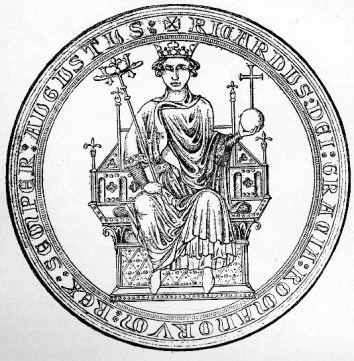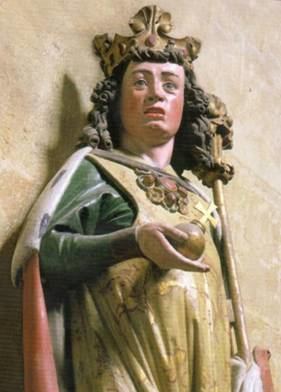Coronation 27 May 1257 Name Richard, 1st Earl Role Count of Poitou | Successor Rudolph I of Germany Siblings Henry III of England Successor Edmund, 2nd Earl | |
 | ||
Reign 13 January 1257 – 2 April 1272 Born 5 January 1209Winchester Castle, Hampshire, England ( 1209-01-05 ) Burial Hailes Abbey, Gloucestershire Died April 2, 1272, Berkhamsted Castle, Berkhamsted, United Kingdom Spouse Beatrice of Falkenburg (m. 1269), Sanchia of Provence (m. 1243), Isabel Marshal (m. 1231) Children Edmund, 2nd Earl of Cornwall, Henry of Almain, Sir Richard of Cornwall Parents John, King of England, Isabella of Angouleme Similar People Henry III of England, Sanchia of Provence, John - King of England, Isabel Marshal, Isabella of Angouleme | ||
Predecessor William II of Holland | ||
Richard 1st earl of cornwall
Richard (5 January 1209 – 2 April 1272), second son of John, King of England, was the nominal Count of Poitou (1225-1243), Earl of Cornwall (from 1225) and King of Germany (from 1257). He was one of the wealthiest men in Europe and joined the Barons' Crusade, where he achieved success as a negotiator for the release of prisoners and assisted with the building of the citadel in Ascalon.
Contents
- Richard 1st earl of cornwall
- Early life
- Marriage to Isabel 123140
- On Crusade and marriage to Sanchia 124043
- Poitou and Sicily
- Elected King of Germany 1256
- Later life death and successors
- Marriages and legitimate progeny
- Joan de Valletort
- References

Early life

He was born 5 January 1209 at Winchester Castle, the second son of John, King of England and Isabella of Angoulême. He was made High Sheriff of Berkshire at the age of only eight, was styled Count of Poitou from 1225 and in the same year, at the age of sixteen, his brother King Henry III gave him Cornwall as a birthday present, making him High Sheriff of Cornwall. Richard's revenues from Cornwall helped make him one of the wealthiest men in Europe. Though he campaigned on King Henry's behalf in Poitou and Brittany, and served as regent three times, relations were often strained between the brothers in the early years of Henry's reign. Richard rebelled against him three times, and had to be bought off with lavish gifts.
In 1225 Richard traded with Gervase de Tintagel, swapping the land of Merthen (originally part of the manor of Winnianton) for Tintagel Castle. It has been suggested that a castle was built on the site by Richard in 1233 to establish a connection with the Arthurian legends that were associated by Geoffrey of Monmouth with the area. The castle was built in a more old-fashioned style for the time to make it appear more ancient. Richard hoped that, in this way, he could gain the Cornish people's trust, since they were suspicious of outsiders. The castle itself held no real strategic value.
The dating to the period of Richard has superseded Ralegh Radford's interpretation which attributed the earliest elements of the castle to Earl Reginald de Dunstanville and later elements to Earl Richard. Sidney Toy, however, has suggested an earlier period of construction for the castle.
Marriage to Isabel, 1231–40
In March 1231 he married Isabel Marshal, the wealthy widow of the Earl of Gloucester, much to the displeasure of his brother King Henry, who feared the Marshal family because they were rich, influential, and often opposed to him. Richard became stepfather to Isabel's six children from her first husband. In that same year he acquired his main residence, Wallingford Castle in Berkshire (now Oxfordshire), and spent much money on developing it. He had other favoured properties at Marlow and Cippenham in Buckinghamshire. Isabel and Richard had four children, of whom only their son, Henry of Almain, survived to adulthood. Richard opposed Simon de Montfort, and rose in rebellion in 1238 to protest against the marriage of his sister, Eleanor, to Simon. Once again he was placated with rich gifts. When Isabel was on her deathbed in 1240, she asked to be buried next to her first husband at Tewkesbury, but Richard had her interred at Beaulieu Abbey instead. As a pious gesture, however, he sent her heart to Tewkesbury.
On Crusade and marriage to Sanchia, 1240–43
Later that year Richard departed for the Holy Land, leading the second host of crusaders to arrive during the Barons' Crusade. He fought no battles but managed to negotiate for the release of prisoners (most notably Amaury VI of Montfort) and the burials of crusaders killed at a battle in Gaza in November 1239. He also refortified Ascalon, which had been demolished by Saladin. On his return from the Holy Land, Richard visited his sister Isabella, the empress of Frederick II.
After the birth of Prince Edward in 1239, provisions were made in case of the king's death, which favoured the Queen and her Savoyard relatives and excluded Richard. To keep him from becoming discontented King Henry and Queen Eleanor brought up the idea of a marriage with Eleanor's sister Sanchia shortly after his return on 28 January 1242. On his journey to the Holy Land, Richard had met her in Provence, where he was warmly welcomed by her father Raymond Berenger IV and had fallen in love with this beautiful girl. Richard and Sanchia (whom the English called Cynthia) married at Westminster in November 1243.
This marriage tied him closely to the royal party. Eleanor and Sanchia's youngest sister Beatrice would marry Charles I of Naples, while their oldest sister Margaret had married Louis IX of France. The marriages of the kings of France and England, and their two brothers to the four sisters from Provence improved the relationship between the two countries, which led up to the Treaty of Paris.
Poitou and Sicily
Richard was appointed count of Poitou some time before August 1225. However, Richard's claims to Gascony and Poitou were never more than nominal, and in 1241 King Louis IX of France invested his own brother Alphonse with Poitou. Moreover, Richard and Henry's mother, Isabella of Angoulême, claimed to have been insulted by the French queen. They were encouraged to recover Poitou by their stepfather, Hugh X of Lusignan, but the expedition turned into a military fiasco after Lusignan betrayed them. Richard conceded Poitou around December 1243.
The pope offered Richard the crown of Sicily, but according to Matthew Paris he responded to the extortionate price by saying, "You might as well say, 'I make you a present of the moon – step up to the sky and take it down.'" Instead, his brother King Henry purchased the kingdom for his own son Edmund.
Elected King of Germany, 1256
Although Richard was elected in 1256 as King of Germany by four of the seven German Electoral Princes (Cologne, Mainz, the Palatinate and Bohemia), his candidacy was opposed by Alfonso X of Castile who was elected by Saxony, Brandenburg and Trier. The pope and King Louis IX of France favoured Alfonso, but both were ultimately convinced by the powerful relatives of Richard's sister-in-law, Eleanor of Provence, to support Richard. Ottokar II of Bohemia, who at first voted for Richard but later elected Alfonso, eventually agreed to support the earl of Cornwall, thus establishing the required simple majority. So Richard had to bribe only four of them, but this came at a huge cost of 28,000 marks. On 27 May 1257 the archbishop of Cologne himself crowned Richard "King of the Romans" in Aachen; however, like his lordships in Gascony and Poitou, his title never held much significance, and he made only four brief visits to Germany between 1257 and 1269.
Later life, death and successors
He founded Burnham Abbey in Buckinghamshire in 1263, and the Grashaus, Aachen in 1266.
He joined King Henry in fighting against Simon de Montfort's rebels in the Second Barons' War (1264–67). After the shattering royalist defeat at the Battle of Lewes, Richard took refuge in a windmill, was discovered, and was imprisoned until September 1265.
In December 1271, he had a stroke. His right side was paralysed and he lost the ability to speak. On 2 April 1272, Richard died at Berkhamsted Castle in Hertfordshire. He was buried next to his second wife Sanchia of Provence and Henry of Almain, his son by his first wife, at Hailes Abbey, which he had founded.
After his death, a power struggle ensued in Germany, which only ended in 1273 with the emergence of a new Roman King, Rudolph I of Habsburg, the first scion of a long-lasting noble family to rule the empire. In Cornwall, Richard was succeeded by Edmund, son of his second wife Sanchia.
Marriages and legitimate progeny
Richard of Cornwall married three times:
He married his first wife Isabel Marshal, on 30 March 1231 at Fawley, Buckinghamshire. Her parents were William Marshal, 1st Earl of Pembroke and Isabel de Clare, daughter of Sir Richard "Strongbow" de Clare and Aoife MacMurrough.On 17 January 1240, Isabel died giving birth at Berkhamsted Castle. She was buried at Beaulieu Abbey.Richard and Isabel had three sons and a daughter:Joan de Valletort
Richard had a mistress named Joan. Her origins are unknown, but she was married to Ralph de Valletort (d. 1267), feudal baron of Harberton, Devon and feudal baron of Trematon, Cornwall; and later Sir Alexander Okeston of Modbury, Devon.
With the Earl of Cornwall, Joan de Valletort had three sons, and two daughters:
